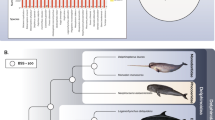Abstract
In order to perform a well-balanced comparative transcriptomic analysis, the reference genome and annotations for all species included in the comparison must be of a similar quality and completeness. Frequently, comparative transcriptomic analyses include non-model organisms whose annotations are not as well curated; this inequality can lead to biases.
To avoid potential biases stemming from incomplete annotations, a comparative transcriptomic analysis can incorporate de novo transcriptome assemblies for each species, which reduces this disparity. This chapter covers all of the steps which are necessary to run a comparative transcriptomic analysis with de novo transcriptome assemblies, from the first step of the experimental design to the sequencing, and ultimately the bioinformatic analysis.
Access this chapter
Tax calculation will be finalised at checkout
Purchases are for personal use only
Similar content being viewed by others
References
Wohlbach DJ, Thompson DA, Gasch AP, Regev A (2009) From elements to modules: regulatory evolution in Ascomycota fungi. Curr Opin Genet Dev 19:571–578. https://doi.org/10.1016/j.gde.2009.09.007
Brion C, Lutz SM, Albert FW (2020) Simultaneous quantification of mrna and protein in single cells reveals post-transcriptional effects of genetic variation. Elife 9:1–34. https://doi.org/10.7554/eLife.60645
Blevins WR, Ruiz-Orera J, Messeguer X et al (2021) Uncovering de novo gene birth in yeast using deep transcriptomics. Nat Commun 12:604. https://doi.org/10.1038/s41467-021-20911-3
Gasch AP (2007) Comparative genomics of the environmental stress response in ascomycete fungi. Yeast. 24:961–976. https://doi.org/10.1002/yea.1512
Tsankov AM, Thompson DA, Socha A et al (2010) The role of nucleosome positioning in the evolution of gene regulation. PLoS Biol 8:e1000414. https://doi.org/10.1371/journal.pbio.1000414
Bolger AM, Lohse M, Usadel B (2014) Trimmomatic: a flexible trimmer for Illumina sequence data. Bioinformatics 30:2114–2120. https://doi.org/10.1093/bioinformatics/btu170
Andrews S, Krueger F, Segonds-Pichon A et al (2010) FASTQC: a quality control tool for high throughput sequence data. Babraham Bioinformatics, pp 5–9
Langmead B, Salzberg SL (2012) Fast gapped-read alignment with Bowtie 2. Nat Methods 9:357–359. https://doi.org/10.1038/nmeth.1923
Wingett SW, Andrews S (2018) Fastq screen: A tool for multi-genome mapping and quality control [version 1; referees: 3 approved, 1 approved with reservations]. F1000Res 7:1–13. https://doi.org/10.12688/f1000research.15931.1
Li H, Handsaker B, Wysoker A et al (2009) The sequence alignment/map format and SAMtools. Bioinformatics 25:2078–2079. https://doi.org/10.1093/bioinformatics/btp352
Grabherr MG, Brian JH, Moran YJ, Levin Z, Thompson DA, Amit I, Adiconis X, Fan L, Raychowdhury R, Zeng Q, Chen Z, Mauceli E, Hacohen N, Gnirke A, Rhind N, Palma F, Birren BW, Friedman N, Regev A (2013) Trinity: reconstructing a full-length transcriptome without a genome from RNA-Seq data. Nat Biotechnol 29:644–652. https://doi.org/10.1038/nbt.1883.Trinity
Smith-Unna R, Boursnell C, Patro R et al (2016) TransRate: reference-free quality assessment of de novo transcriptome assemblies. Genome Res 26:1134–1144. https://doi.org/10.1101/gr.196469.115
Wu TD, Watanabe CK (2005) GMAP: a genomic mapping and alignment program for mRNA and EST sequences. Bioinformatics 21:1859–1875. https://doi.org/10.1093/bioinformatics/bti310
Trapnell C, Roberts A, Goff L et al (2012) Differential gene and transcript expression analysis of RNA-seq experiments with TopHat and cufflinks. Nat Protoc 7:562–578. https://doi.org/10.1038/nprot.2012.016
Patro R, Duggal G, Love MI et al (2017) Salmon provides fast and bias-aware quantification of transcript expression. Nat Methods 14:417–419. https://doi.org/10.1038/nmeth.4197
Camacho C, Coulouris G, Avagyan V et al (2009) BLAST+: architecture and applications. BMC Bioinformatics 10:1–9. https://doi.org/10.1186/1471-2105-10-421
Treangen TJ, Messeguer X (2006) M-GCAT: interactively and efficiently constructing large-scale multiple genome comparison frameworks in closely related species. BMC Bioinformatics 7:433. https://doi.org/10.1186/1471-2105-7-433
Blevins WR, Carey LB, Mar AM (2019) Transcriptomics data of 11 species of yeast identically grown in rich media and oxidative stress conditions. BMC Res Notes 12:250. https://doi.org/10.1186/s13104-019-4286-0
Moyers BA, Zhang J (2018) Toward reducing phylostratigraphic errors and biases. Genome Biol Evol 10:2037–2048. https://doi.org/10.1093/gbe/evy161
Weisman CM, Murray AW, Eddy SR (2020) Many, but not all, lineage-specific genes can be explained by homology detection failure. PLoS Biol 18:1–24. https://doi.org/10.1371/journal.pbio.3000862
Acknowledgments
This work was made possible by several grants including PGC2018- 094091-B-I00, BFU2015-65235-P, BFU2015-68351-P, BFU2016-80039-R, TIN2015-69175-C4-3-R, and RTI2018-094403-B-C33 from the Spanish Government FEDER (EU), as well as PT17/0009/0014 from the Instituto de Salud Carlos III. We also received support from grants 014SGR1121, 2014SGR0974, 2017SGR1054, and 2017SGR01020 from the Agència de Gestió d’Ajuts Universitaris i de Recerca Generalitat de Catalunya (AGAUR), and MDM-2014-0370 from the “Maria de Maeztu” Program for Units of Excellence in R&D.
We would like to thank Dr. Ksenia Pugach and the Verstrepen lab for donating cultures of several species of yeast. We also thank the sequencing facilities of the Centre for Genomic Regulation (CRG) and Universitat Pompeu Fabra (UPF) for their contributions.
Author information
Authors and Affiliations
Corresponding author
Editor information
Editors and Affiliations
1 Electronic Supplementary Material
Data S1
(ODT 20 kb)
Rights and permissions
Copyright information
© 2022 The Author(s), under exclusive license to Springer Science+Business Media, LLC, part of Springer Nature
About this protocol
Cite this protocol
Blevins, W.R. (2022). Identification of Taxonomically Restricted Transcripts from Illumina RNA Sequencing Data. In: Devaux, F. (eds) Yeast Functional Genomics. Methods in Molecular Biology, vol 2477. Humana, New York, NY. https://doi.org/10.1007/978-1-0716-2257-5_7
Download citation
DOI: https://doi.org/10.1007/978-1-0716-2257-5_7
Published:
Publisher Name: Humana, New York, NY
Print ISBN: 978-1-0716-2256-8
Online ISBN: 978-1-0716-2257-5
eBook Packages: Springer Protocols




